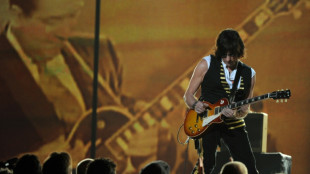
-
 Fritz reaches ATP Finals title decider with Sampras mark in sight
Fritz reaches ATP Finals title decider with Sampras mark in sight
-
All eyes on G20 for breakthrough as COP29 climate talks stall

-
 Fritz battles past Zverev to reach ATP Finals title decider
Fritz battles past Zverev to reach ATP Finals title decider
-
Xi, Biden to meet as Trump return looms

-
 Kane warns England must protect team culture under new boss
Kane warns England must protect team culture under new boss
-
Italy beat Japan to reach BJK Cup semi-finals

-
 Farmers target PM Starmer in protest against new UK tax rules
Farmers target PM Starmer in protest against new UK tax rules
-
Shiffrin masters Levi slalom for 98th World Cup win

-
 Italy's Donnarumma thankful for Mbappe absence in France showdown
Italy's Donnarumma thankful for Mbappe absence in France showdown
-
McIlroy in three-way tie for Dubai lead

-
 Bagnaia wins Barcelona MotoGP sprint to take season to final race
Bagnaia wins Barcelona MotoGP sprint to take season to final race
-
Ukraine's Zelensky says wants to end war by diplomacy next year

-
 Shiffrin wins Levi slalom for 98th World Cup victory
Shiffrin wins Levi slalom for 98th World Cup victory
-
Israel pummels south Beirut as Lebanon mulls truce plan

-
 Religious Jews comfort hostages' families in Tel Aviv
Religious Jews comfort hostages' families in Tel Aviv
-
German Greens' Robert Habeck to lead bruised party into elections

-
 Johnson bags five as Australia beat Pakistan to seal T20 series
Johnson bags five as Australia beat Pakistan to seal T20 series
-
Zelensky says wants to end war by diplomacy next year

-
 Rugby Union: Wales v Australia - three talking points
Rugby Union: Wales v Australia - three talking points
-
10 newborns killed in India hospital fire

-
 Veteran Le Cam leads Vendee Globe as Sorel is first to quit
Veteran Le Cam leads Vendee Globe as Sorel is first to quit
-
Bagnaia on pole for Barcelona MotoGP, Martin fourth

-
 UN climate chief urges G20 to spur tense COP29 negotiations
UN climate chief urges G20 to spur tense COP29 negotiations
-
Rauf takes four as Pakistan hold Australia to 147-9 in 2nd T20

-
 World not listening to us, laments Kenyan climate scientist at COP29
World not listening to us, laments Kenyan climate scientist at COP29
-
Philippines warns of 'potentially catastrophic' Super Typhoon Man-yi

-
 Wales take on Australia desperate for victory to avoid unwanted record
Wales take on Australia desperate for victory to avoid unwanted record
-
Tyson beaten by Youtuber Paul in heavyweight return

-
 Taylor holds off bloodied Serrano to retain undisputed crown
Taylor holds off bloodied Serrano to retain undisputed crown
-
Japan PM expresses concern to Xi over South China Sea situation

-
 Tens of thousands flee as Super Typhoon Man-yi nears Philippines
Tens of thousands flee as Super Typhoon Man-yi nears Philippines
-
Hoilett gives Canada win in Suriname as Mexico lose to Honduras

-
 Davis, James spark Lakers over Spurs while Cavs stay perfect
Davis, James spark Lakers over Spurs while Cavs stay perfect
-
Mushroom houses for Gaza? Arab designers offer home-grown innovations

-
 Gabon votes on new constitution hailed by junta as 'turning point'
Gabon votes on new constitution hailed by junta as 'turning point'
-
Young Libyans gear up for their first ever election

-
 Vice tightens around remaining civilians in eastern Ukraine
Vice tightens around remaining civilians in eastern Ukraine
-
Dutch coalition survives political turmoil after minister's resignation

-
 Uruguay end winless run with dramatic late win over Colombia
Uruguay end winless run with dramatic late win over Colombia
-
Max potential: 10 years since a teenage Verstappen wowed in Macau

-
 Tens of thousands flee as Typhoon Man-yi nears Philippines
Tens of thousands flee as Typhoon Man-yi nears Philippines
-
Is Argentina's Milei on brink of leaving Paris climate accord?

-
 Big Bang: Trump and Musk could redefine US space strategy
Big Bang: Trump and Musk could redefine US space strategy
-
Revolution over but more protests than ever in Bangladesh

-
 Minister resigns but Dutch coalition remains in place
Minister resigns but Dutch coalition remains in place
-
Ireland won 'ugly', says relieved Farrell

-
 Stirring 'haka' dance disrupts New Zealand's parliament
Stirring 'haka' dance disrupts New Zealand's parliament
-
England's Hull grabs lead over No.1 Korda at LPGA Annika

-
 Kosovo players walk off in Romania after 'Serbia' chants, game abandoned
Kosovo players walk off in Romania after 'Serbia' chants, game abandoned
-
Kosovo players walk off in Romania game after 'Serbia' chants


Visitors trickle back to Syria citadel used by jihadists
An ancient lake-side fortress once used by jihadists to launch attacks is slowly regaining its status as a key cultural destination, attracting visitors from across war-torn Syria.
Families posed for pictures under the hot June sun, some perched on an ancient brick wall overlooking the banks of Lake Assad, a man-made reservoir in northern Syria's Raqa province.
Abdullah al-Jaber was visiting Qalaat Jaabar with his children for the first time even though they live less than an hour away by car.
He said he would often show them photographs of his childhood trips to the citadel in the hope that they would one day visit it together.
"Their dream was to see Qalaat Jaabar," the 41-year-old said with a smile.
"Today I brought them here to see it."
The Islamic-era landmark has attracted a growing number of visitors since the start of summer as security has improved in recent years.
The historic fortified site dates back to the Seljuk and Mamluk periods and is considered one of Syria's most preeminent fortresses.
The castle became an island when Lake Assad was formed in 1974 by the completion of the Tabqa dam on the Euphrates River.
Qalaat Jaabar is connected to the mainland by a thin causeway. It has 35 bridges and a mosque and it used to shelter a museum with dozens of artefacts, but that was ransacked by the Islamic State group.
- Boat rides and picnics -
The site lies around 50 kilometres (30 miles) from Raqa city, once the de facto Syrian capital of IS's self-proclaimed caliphate.
In 2017, US-backed Kurdish fighters retook the fortress from the jihadists, who had ruled over the area since 2014.
The hilltop citadel, which overlooked IS' largest Syrian prison, was a strategic spot the group used to launch attacks and monitor movements around the detention facility.
On the outskirts of the citadel, IS "dug up trenches to train child soldiers," said Raqa resident Mohammad, 45, who asked to use a pseudonym due to security concerns.
"Residents were banned from visiting because it was a military area... but now it is recovering," he said.
Boat rides and picnics on Lake Assad's sandy shores have also helped turn the citadel back into a popular destination for families.
Outside the towering walls, young men laid a fruit spread and smoked hookah pipes in the shade, as loud Arabic music blasted around them.
Radwan Kahawati said he came all the way from the coastal city of Latakia, a five-hour drive by car, to visit Qalaat Jaabar with his family.
"We came here for tourism and for a change of scene," he said.
"My daughter told me: 'take us to Jaabar,' because she learnt about it at school."
R.Chavez--AT




